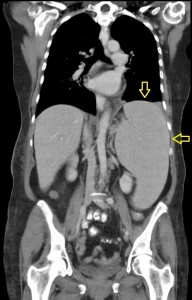Enlarged spleen or Splenomegaly
Enlargement of the spleen, or splenomegaly (ICD-10: R16.1), is a non-specific symptom that may accompany diseases limited to the spleen, as well as being a consequence of multi-organ dysfunction.

The role of the spleen in the human body
The spleen is an extensive blood reservoir and the largest lymphatic organ in humans, but is not essential for life. Under physiological conditions, its mass does not exceed 150 g and depends on the amount of blood stored.
The dimensions of a normal spleen should not exceed: length – 120 mm, width – 70 mm, thickness – 40 mm. A so-called accessory spleen may be present in the splenic hilum (this is an anatomical variant in up to 11% of the population). Spleen enlargement is palpable on physical examination if it exceeds 1.5 times its size and its weight increases to more than 300 g. In massive enlargement, the spleen may even reach more than 1000 g.
Another feature of the spleen is its capacity for what is known as subcapsular rupture, or two-stage delayed rupture, following abdominal trauma/injury in an accident and may be one of the indications for its removal. Splenic enlargement can also be a sign of trauma and subcapsular haematoma. The division of splenomegaly is contained in the WHO five-stage classification.
Hypersplenism, or large spleen syndrome, is a condition in which splenomegaly is accompanied by anaemia and/or leukopenia and/or thrombocytopenia.
Splenomegaly – causes and symptoms
An enlarged spleen causes pain and a sensation of distension, most often in the left hypochondrium and in the mesogastrium. Spleen enlargement may be accompanied by back pain, heartburn, nausea, vomiting, petechiae, weight loss, fatigue, pallor, dyspnea, susceptibility to infection.
Splenomegaly can accompany the following diseases: neoplastic, infectious, metabolic, immunological and storage diseases. One cause of an enlarged spleen may be cirrhosis. Often, enlargement of the spleen runs together with enlargement of the liver – this condition is called hepatosplenomegaly.
Most often splenomegaly has an infectious basis, but it can also be a sign of proliferative processes, mainly tumours of the blood/spleen and lymphatic system (mainly lymphomas, leukaemias, also myelofibrosis, malignant granulomatosis).
Other causes of splenic enlargement include infectious viral diseases (e.g. cytomegalovirus, mononucleosis, hepatitis), bacterial diseases (e.g. Lyme disease), parasitic diseases (e.g. echinococcosis), autoimmune and systemic diseases (e.g. Lupus Erythematosus, Sarcoidosis), metabolic storage diseases (e.g. Gaucher Disease, Pompe Disease).
The spleen may be enlarged in the course of portal vein thrombosis or splenic vein thrombosis, as well as in splenic metastases and primary splenic tumours. Among focal lesions, half are benign (most commonly splenic infarction). Splenic metastases occur in approximately 7-8% of patients with malignant neoplasms (most commonly from ovarian, uterine, breast and lung cancers).
Splenomegaly – diagnosis and treatment
In addition to the physical examination, imaging studies such as ultrasonography (USG), computed tomography (CT) or magnetic resonance imaging (MRI) are used to diagnose splenomegaly.
Depending on the primary cause of splenomegaly, therapeutic procedures focus primarily on the treatment of the underlying disease and treatment may require splenectomy (e.g. in refractory immune thrombocytopenia, ITP).